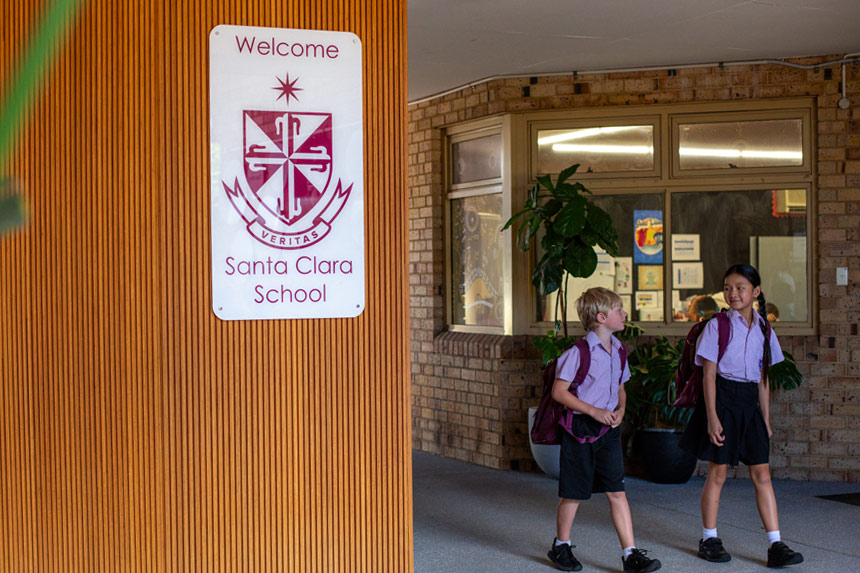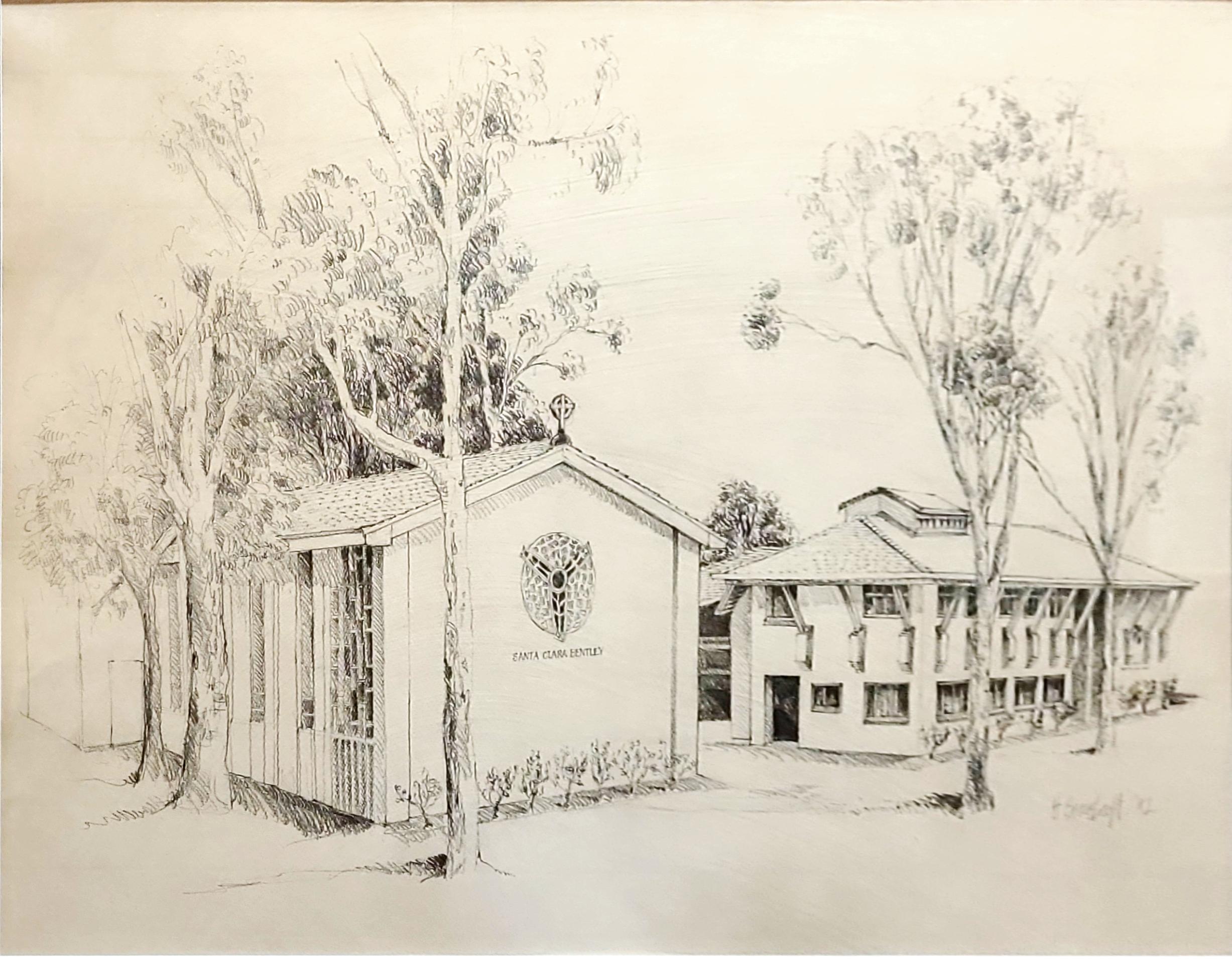Our History
The Congregation of Dominican Sisters of Western Australia owes its existence to the establishment of an Order of Sisters by St Dominic in 1216.
Born in Spain in 1170, St Dominic committed himself to preaching God’s Truth through prayerful contemplation and devotion to the Scriptures. He gave to his Sisters a clear vision of their vocation – to contemplate Christ’s word and to hand it on to others.
When Mother Gabriel Gill and the other pioneer Sisters arrived at Greenough from New Zealand in June 1899, they followed that same vision, quickly establishing schools and pioneering Catholic Education in nearby areas, in the harsh environment of the Murchison Goldfields and in the towns of the Mid-west Wheat Belt. The particular charism of these ordinary people of great faith was recognised by their desire to share the spirit of Dominic, whose life was characterised by joyfulness of heart, compassion, love of contemplation and prayer, and generosity of mind and spirit – a spirit the Sisters who have followed, have tried to emulate, meeting each new challenge with dedication to promoting faith and education in the city and rural areas.

Santa Clara School History
The Congregation of Dominican Sisters of Western Australia owes its existence to the establishment of an Order of Sisters by St Dominic in 1216.
Born in Spain in 1170, St Dominic committed himself to preaching God’s Truth through prayerful contemplation and devotion to the Scriptures. He gave to his Sisters a clear vision of their vocation – to contemplate Christ’s word and to hand it on to others.
When Mother Gabriel Gill and the other pioneer Sisters arrived at Greenough from New Zealand in June 1899, they followed that same vision, quickly establishing schools and pioneering Catholic Education in nearby areas, in the harsh environment of the Murchison Goldfields and in the towns of the Mid-west Wheat Belt. The particular charism of these ordinary people of great faith was recognised by their desire to share the spirit of Dominic, whose life was characterised by joyfulness of heart, compassion, love of contemplation and prayer, and generosity of mind and spirit – a spirit the Sisters who have followed, have tried to emulate, meeting each new challenge with dedication to promoting faith and education in the city and rural areas.
In the Geraldton Diocese, many children were unable to attend Catholic schools because of the remoteness of the areas in which they lived. To overcome this, a programme of Religion by Letter was introduced and -the annual Bushies’ Schools were conducted at various times in Dongara, Leonora, Geraldton, Exmouth, Shark Bay and Port Hedland.
From 1972 until 1986, the Sisters conducted a Motor Mission with its base at Morawa from where they visited schools and homes at Morawa, Perenjori, Latham, Buntine, Mingenew, Dongara, Walkaway, Cue, Meekatharra, Yuna, Nabawa and, after the closure of the school at Three Springs in 1974, at Eneabba, Carnamah and Coorow.
In 1941, a foundation was made in the Archdiocese of Perth at Bedford. The Sisters lived in a house in Wood St until St Dominic’s Convent was built in 1942, and taught in St Peter’s School. The Secondary School, St Thomas Aquinas, was built in 1955.
Santa Clara School was established in 1953 and the Convent built in1958.
In 1999, the Dominican Sisters of Western Australia years of pursuing Dominic’s vision, inspired by his life and work as they continue to “contemplate and pass on to others the fruits of their contemplation” into the 21st Century.
The original Santa Clara school/church was a one room stone building which was used for both educational and religious purposes. Surrounded by sand, bush and the devout and tenacious faith of the pioneer Bentley settlers, this modest structure was officially opened and blessed by Archbishop Prendiville in August 1952. A separate church was completed in 1963. By then the school had increased to six classrooms.
The first Santa Clara teachers were Dominican Sisters. In the true spirit of St Dominic, the Sisters taught in the school and worked in the parish for nearly forty years and their example of love and service is built into the very walls and traditions of Santa Clara. A beautiful commemorative banner dedicated to the Sisters hangs in the school library.
In 1992 the old buildings were finally replaced by a modern two storey school complex which includes administrative offices, a library, a canteen and a computing centre, as well as seven classrooms. The pre-primary was completed in 1993.
In renewed beauty and strength, therefore, Santa Clara School continues to meet the challenge of educating for the future.

The Crest (Coat of Arms)
Inspiration for the Coat of Arms came from St Dominic’s noble parentage.
From his mother’s side came the cross. Jane of Aza’s family belonged to the knights of Calatrava, who wore a cross of this description. The cross “fleury” has ends that flower out to a lily shape. It symbolises sacrifice flowering into joy.
The eight-pointed star bears a marked resemblance to the face of the compass which points to all quarters of the globe. A star is a symbol of light.
From his father’s side came the black and white Guzman shield, divided into eight sections. Black symbolises penance and white is a symbol of joy.
The word “Veritas” which means “Truth” remind us that St Dominic sought the truth of God and in his preaching, he shared this truth with others.

School Factions
Larney
Sister Anne Larney taught at Santa Clara as a young Nun during the 1960’s and was known as Sister M. Bernard. She lived in the convent with other Nuns which is the house which the Priest now lives. At the time, all classes except for one were taught by the Dominican Sisters. She left Santa Clara after a few years and worked in country areas including the Motor mission and other Dominical schools. She returned to Santa Clara as Principal from 1983-1992. She proved to be an outstanding leader who was able to create a happy, professional, cohesive and cooperative staff. This resulted in a safe and supportive learning environment for the children and families. She was responsible for leading the rebuild of the whole school, a modern two-story school complex which included administrative offices, a library, a canteen and a computing centre, as well as seven classrooms. This is the building we have today. She kept the Irish heritage alive within the school through various celebrations and feast days. She had a special love for Irish dancing and brought a special joy to the school community. Sister Anne Larney was the last Dominican Principal at Santa Clara. She left a legacy, not just in rebuilding the school, but in her relationships with people. She was an inspiration to others through her spiritual and prayer life and the high standards she set for herself and staff members. She showed genuine care and concern for others and was understanding and compassionate to those in need at various times.

Dominic
St Dominic was born in Caleruega, Spain in 1170. His parents were members of the Spanish nobility and related to the ruling family. Dominic’s father was Felix Guzman and was the royal warden of the village. His mother, Bl. Joan of Aza, was a holy woman in her own right. Dominic was born in Spain and the youngest of four children. Dominic left his mother when he was seven to begin school with his uncle who was a priest. After years of study, he became a priest himself and lived a quiet life of prayer and obedience with other virtuous priests. However, God had other plans for Dominic, he was meant to find the Dominican Order to preach Faith and rid of all false teachings. When Dominic was on a trip to France, there was a heresy called Albigensiamism, this was where people were doing great harm and did not have a good moral compass. They taught people did not have free will, that marriage was bad and that harming the old and sick could be good. St Dominic felt much pity for these people who had joined the heresy and felt inspired to help them. St Dominic’s Order of Preachers conquered that dangerous heresy though the use of: prayer, especially the holy Rosary of the Blessed Virgin Mary, humility, humiliation and preaching’s. Dominic, his bishop and three Cistercian monks went from city to city preaching the truth of Christ. Soon people returned to faith, not just because of what the preachers said but by how they lived. In 1206 Dominic began an order of religious women. Although, at one point the bishop passed away, and the three monks left Dominic. A war even broke out between the heretics and some Church members. Dominic felt that he was failing but was supported by the prayers and encouragement of the Sisters. By 1215 a few men joined Dominic in preaching, and this was where he founded the Dominicans or otherwise known as the Order of Preachers. Saint Dominic was the founder of the Dominican Order. Saint Dominic is the reason that we have The Dominican Values of: Truth, Community, Justice, Compassion and Partnership Truth was Dominic’s motto and was his goal. St Dominic cared deeply for the poor and cared for those in need. In 1191, a famine left many people deserted and homeless across Spain. Dominic sold everything he had, including his furniture and clothes, and bought food for the poor. When he sold his manuscripts, required for study, he replied, “Would you have me study from these dead skins when people are dying of hunger?” Dominic realised that to be a true witness of God and the Gospel, Dominicans could not be wealthy as they may be persuaded to be drawn by material goods. Dominic and his follows also deeply loved the Blessed Virgin Mary and spread devotion through her Rosary. Dominic cared deeply for his community he was able to inspire them to love and forgive one another. He was known for his love and honesty. For Dominic, love for people was part of his love for God.

Clare
St Clare is an Italian saint. She was one of the first followers of Saint Francis of Assisi. Saint Clare of Assisi was of noble birth and was originally known as Chiara Offreduccio di Favaronne in Assisi – she was the oldest child in her family. When she was 18 years old, she heard Francis of Assisi preaching. She was extremely moved by his sermon, so she ran away to join him. She heard him say: “When there is poverty with joy, there is inner peace.” She became deeply determined to live out the gospel message in a radical way. On the evening of Palm Sunday, she secretly left her paternal home with her cousin Pacifica, never to return. In the dead of night lit only by torches, Clare met Francis and his friars at the ‘Portiuncola’. There, in the little chapel of ‘Mary of the Angels’, Francis cut her long blond hair and Clare laid aside her fine clothes, clothing herself in a simple dress of sackcloth and a thick veil. She vowed from that moment on to give herself totally to God, her eternal spouse. Francis didn’t have a place for women to stay, so he sent her to the Benedictine convent in San Paulo. Clare’s relatives found out where she was staying, but when they arrived to take her back home (they had planned for her to be married at 15), she clung to the altar saying she would only wed Christ. When she was staying in another monastery in Panzo, she was reunited with her younger sister, Agnes. Later, when she was 21, she was moved to another convent next to the San Damiano church, where she was appointed the superior for 40 years. In that church, she was reunited with her mother and her other sister named Beatrice. Clare was the first woman to follow the life of radical poverty practiced by St Francis of Assisi Saint Clare of Assisi will be remembered for founding the “Order of Poor Ladies”, later named “Poor Clares.” The order of Poor Clares was an order that had strict rules, such as silence vows, poverty, and strict fasting. They wore no shoes, ate no meat, lived in a poor house and kept silent at most times. The Poor Clares was an order for women so they could become closer to God.

Catherine
St Catherine of Siena was born in Italy on March 25th, 1347 and passed away at the age of 33. She was declared a doctor of the church in 1970 and a patron saint of Europe in 1999. At the age of 6-7, when returning from a walk with her brother, Catherine saw Jesus clothed in his sacred garments and seated on a throne on top of the church of Dominicans, together with St Peter, St Paul, St John and the Evangelist. This was the start to her loving relationship with God. The Holy Spirit was seen frequently within Catherine’s soul which was identified to be of mystical phenomena that were often seen by others. For example, when Catherine was a child, she used to be carried up and down the stairs in the air, with her feet barely touching the steps as she moved. Catherine was also seen levitating during prayer, and a priest once said that he saw the Holy Communion fly from his hand straight into Catherine’s mouth like a miraculous Frisbee. Catherine’s family wanted her to get married, but she did not want to. So, she cut off her hair as a sign that she did not want to marry and was only committed to Jesus, and would only serve and marry him. Catherine was known for her truth and purity, and she was known as someone who stood up for those who were being mistreated. She showed the virtue of care by devoting her life to help others, especially those who were really sick and no one wanted to help. During the plague she would bring food and clothes to those in need and nurtured patients no one else would touch. Catherine is recognised for her resilience as she could barely read and write but with time, she wrote more than 400 letters and 2 books. Saint Catherine was a member of the Dominican Order and celebrated and followed the Dominican Values of: Truth, Community, Justice, Compassion, Partnership. Saint Catherine is recognised as patroness of fire protection because her sister saw her deep in prayer in the kitchen, engulfed in flames from the stove. When she was pulled out, there was no evidence of burn marks on her body.






